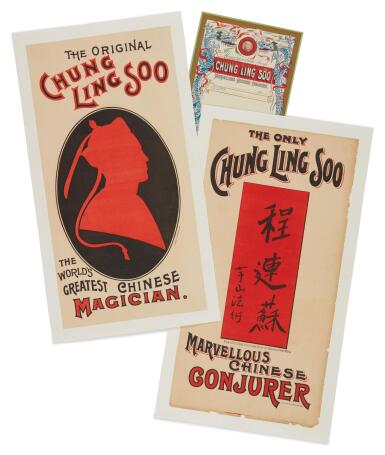The Ricky Jay Collection
The Ricky Jay Collection

Chung Ling Soo (William Ellsworth Robinson) | The Original Visiting Card of Chung Ling Soo
Auction Closed
October 28, 08:54 PM GMT
Estimate
2,000 - 3,000 USD
Lot Details
Description
Chung Ling Soo (William Ellsworth Robinson)
The Only Chung Ling Soo. The Original Visiting Card of Chung Ling Soo. Marvellous Chinese Conjurer. Birmingham: J. Upton, Lith., ca. 1905 — The Original Chung Ling Soo. The World's Greatest Chinese Magician. Birmingham: J. Upton, Lith., ca. 1905 — Memorandum from Chung Ling Soo Marvellous Chinese Conjurer. Np, early 20th century
2 two-color lithograph window cards (572 x 295 mm, or slightly smaller) and a leaf of color lithograph letterhead (313 x 206 mm). Both window cards laid down on linen, the first lightly browned and with minor marginal chipping.
The first window card is the most intriguing of this group—and one of the most intriguing of any of the multitude of promotional materials for Chung Ling Soo. While Chung Ling Soo was an invented persona of William Robinson, his appropriated Chinese name is presented here on his "visiting card" in actual Chinese characters rather than just employing some random symbols intended (like Robinson himself) to "look" Chinese. The magician's name in Chinese, as seen here, is 程連蘇 (as it is written vertically and read from top to bottom, right to left if there are multiple columns), which indicates that his last name is Chung (程) and his first (given) name is Ling Soo (連蘇). So while most western reference books index this name as "Soo, Chung Ling," it should be indexed as "Chung, Ling Soo," and subsequently should be referred to in the English (and pan-European) naming tradition as Ling Soo Chung. Since this is not the name of an actual Chinese person, however, we have presented the name in the same form that Robinson did.
The visiting card contains some further text in smaller Chinese characters that seem intended to say 茅山法術—that is, "the magic of Maoshan" (a mountain in Jiangsu province famous for being a sacred mountain in Daoism). However the 茅 character is missing about two strokes and overall seems that it was copied from another work of Chinese calligraphy by a person without a full understanding of characters and how stroke orders work in characters. The copyist might have been either a westerner or an illiterate Chinese.
We are grateful to our colleague Justin Cheung for his assistance in sorting out this curious matter.
